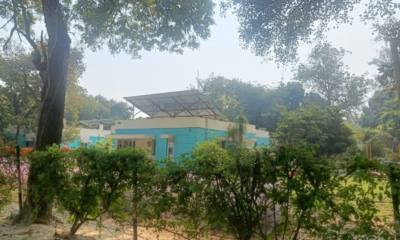EDUNEWS & VIEWS
Trump’s push to abolish the Education Department: Could it really transform schools?
So, what would an America without the Department of Education look like?

President-elect Donald Trump wants the Department of Education gone. During his presidential campaign, Trump made waves by repeatedly pledging to eliminate the U.S. Department of Education, calling it a symbol of federal overreach and an unnecessary drain on taxpayer money. The promise was bold: “We will ultimately eliminate the federal Department of Education,” he declared at a rally in Wisconsin back in 2016. His critics and supporters alike raised eyebrows, but what would actually happen if such a move were to be made?
The Department of Education, created in 1979 under President Jimmy Carter, has long played a pivotal role in shaping America’s education system. If Trump’s plan were to move forward, it could mean sweeping changes to how K-12 schools are funded and how federal education policies are implemented.
The Core Functions of the Department
The Department of Education performs several essential roles in the American education system. For one, it funnels billions of federal dollars to states and schools. Its two major funding programs—Title I and IDEA—help support schools serving low-income students and children with disabilities. These programs provide nearly $28 billion annually to K-12 schools, although they represent only a small fraction of overall school funding. The bulk of K-12 school budgets comes from state and local taxes. The Department of Education also manages federal student loans and financial aid programs, including Pell grants, which distribute about $30 billion annually to help low-income college students.
Without these programs, how would schools and students fare? The answer isn’t clear-cut, but one thing is certain: federal funding has become a significant tool in ensuring access to education, especially for marginalized groups.

The Bureaucratic Web: Oversight and Regulations
In addition to distributing funding, the Department of Education plays an oversight role, ensuring that schools meet federal standards and investigating issues of discrimination. Through its Office of Civil Rights, the department enforces rules aimed at preventing discrimination on the basis of race, gender, and disability in schools. Over the years, the department has also been a key player in regulating hot-button issues—such as protections for transgender students and regulations on student loan forgiveness programs.
But what happens if this regulatory body no longer exists? One potential scenario could involve the transfer of these responsibilities to other federal agencies or a decentralization of decision-making power to state and local governments.
Federal Funds: The Strings Attached
Federal money doesn’t come without conditions. For instance, schools that receive funding through programs like Title I must adhere to certain rules and regulations. These guidelines can sometimes create what many consider “red tape.” For years, critics of the Department have argued that the bureaucracy tied to federal funding slows down school improvement efforts and imposes undue burdens on local administrators.
According to experts, the funding programs might survive, albeit in a different structure
Some policy experts suggest that even if the Department of Education were dissolved, the funding itself could continue—possibly in the form of block grants that offer more flexibility to local districts. But others warn that dismantling the department could result in a loss of essential oversight and services, especially for students with special needs.
What Happens to Federal Education Programs?
Interestingly, many of the funding programs the Department of Education oversees—particularly Title I and IDEA—were in place before the agency itself existed. This raises the question: Would these programs disappear if the department were abolished?
According to experts, the funding programs might survive, albeit in a different structure. Congress, which ultimately controls federal spending, has historically resisted efforts to cut education funding, even during budget negotiations when past presidents proposed cuts. Many believe that, even if the Department were to close its doors, the political and public support for these funding streams would likely push them into different agencies or programs.
Can Congress Actually Abolish the Department of Education?
While Trump’s rhetoric may have made abolition sound simple, shutting down a federal agency is no small feat. It would require an act of Congress—a challenge that previous efforts have failed to overcome. Even President Ronald Reagan, shortly after the department’s creation in 1980, proposed its elimination but eventually backed down due to lack of congressional support. The Trump administration also tried to merge the Education and Labor Departments, but that effort stalled in Congress.
Even if the GOP gains unified control of Washington in the coming years, it remains uncertain whether there will be enough support to completely dismantle the Department of Education.
The Road Ahead
So, what would an America without the Department of Education look like? In reality, it’s likely that some form of federal oversight and funding would continue, but the shape of it could change significantly. If Congress and the president were to act, the most likely outcome would be a shift in how federal funds are distributed—potentially with fewer strings attached—and a reorganization of some of the department’s key functions.
While Trump’s rhetoric may have made abolition sound simple, shutting down a federal agency is no small feat. It would require an act of Congress
Ultimately, the debate about whether to abolish the Department of Education touches on much larger issues: how to balance federal power with state autonomy, how to fund public schools fairly, and how to ensure that all students, regardless of background, have access to a high-quality education.
As the conversation continues, one thing is clear: any significant change to the Department of Education would have profound implications for the future of education in America, particularly for its most vulnerable students. Whether that future is shaped by a more decentralised approach or by a reformed federal agency remains to be seen. But one thing is for sure—the stakes are high.
EDUNEWS & VIEWS
Ambani Donates $18 Million to the Institute of Chemical Technology
Mukesh Ambani, who had chosen to study at ICT over IIT Bombay credited his professor with shaping his professional journey and inspiring the principles that led to Reliance’s growth

Mukesh Ambani, the country’s richest man, had announced a mammoth donation of $18 million to his alma mater, Mumbai’s Institute of Chemical Technology (ICT), on June 6.
Ambani, who is chairman and managing director at Reliance Industries, had been in attendance at a book launch event for Divine Scientist, a biography on Prof. Man Mohan Sharma, Ambani’s ex-teacher and cherished mentor.
Addressing a packed audience at ICT, Ambani said he was invested in ICT’s long-term growth and success in all fronts; advancing research, education, and ideals that Prof. Singh stood for, that is knowledge, sustainability, and nation-building. Sharma, who is professor in chemical engineering at ICT, had been the first engineer from India to be elected as a fellow of the Britain’s prestigious Royal Society.
“This is my Guru Dakshina (offering) [to Prof. Sharma],” Ambani said. Prof. Sharma has had a considerable influence upon him in shaping his professional journey, as well as principles, that led to Reliance’s growth.
In an anecdote he shared with the public, he said, “Prof. Sharma told me, ‘Mukesh, you have to do something big for ICT.’ I replied, ‘Sir, just tell me what to do.’ And he said, ‘Announce $18 million to ICT unconditionally.’ I’m very, very pleased to do that today.”
In the 1970s, Ambani was student at ICT, then known as the University Department of Chemical Technology (or UDCT). He had chosen ICT over an admissions offer at the prestigious Indian Institute of Technology, Bombay.
EDUNEWS & VIEWS
Harvard Pledges $250 Million for Research After Federal Funding Slash
The administration has defended the funding freeze as part of a broader campaign to address what it characterizes as pervasive anti-Semitism on campuses and to roll back diversity programs

Harvard University has announced a $250 million investment to sustain vital research programs in the face of steep federal funding cuts imposed by the Trump administration.
The move follows a sweeping $2.6 billion reduction in government grants to the Ivy League institution, citing alleged discriminatory practices and refusal to comply with federal oversight mandates. The cuts, which Harvard is actively challenging in court, have already suspended or canceled dozens of projects—some of which were considered critical to public health and technological innovation.
University President Alan Garber and Provost John Manning issued a joint statement on Wednesday, emphasizing the urgent need to protect research initiatives. “While we cannot fully offset the financial blow from halted federal support, we are committed to backing essential research during this transitional period,” they said. The university is also working with faculty to secure alternative funding channels.
Harvard has strongly criticized the federal measures, calling the termination of grants “unlawful” and accusing the administration of interfering with academic independence. The university contends that the loss of funding not only halts groundbreaking work but also threatens years of scientific progress.
At the heart of the dispute is a broader political clash over university governance. Harvard, whose endowment reached $53.2 billion in 2024, has become a focal point of the Trump administration’s efforts to reshape higher education policy. The White House has demanded greater control over admissions, hiring, and the political climate on campus—demands Harvard has resisted.
The administration has defended the funding freeze as part of a broader campaign to address what it characterizes as pervasive anti-Semitism on campuses and to roll back diversity programs. Critics argue these moves are part of a larger effort to suppress progressive academic culture and penalize dissent over U.S. foreign policy, especially in light of recent student protests against the war in Gaza.
In recent weeks, federal authorities have also taken steps to revoke visas of international students involved in these demonstrations, accusing them of ties to militant organizations—allegations civil rights groups and university leaders have strongly disputed.
With tensions between the federal government and top academic institutions mounting, Harvard’s legal challenge could set a precedent for how universities navigate political interference while safeguarding research, free speech, and academic autonomy.
EDUNEWS & VIEWS
India is not in competition with any other nation: ISRO Chief
ISRO Chief V. Narayanan urges youth to lead India’s technological revolution

In a powerful address at the 8th edition of the Chhatra Sansad India Conclave (CSI), ISRO (Indian Space Research Organisation) Chairman V. Narayanan inspired over 20,000 young minds to push boundaries and take India to new heights in space exploration and scientific innovation. His message was clear: the nation’s future in technology will be shaped by the youth, and they are crucial in propelling India to the forefront of global advancements.
In his keynote, V. Narayanan, Chairman of ISRO, spoke about India’s ongoing strides in space exploration. He emphasized that India is not in competition with any other nation but is focused solely on advancing its own technological progress. “India’s future is in the hands of its youth. You are the driving force behind the country’s technological and scientific transformation,” Narayanan said, calling for continued innovation in space research.
The conclave, held at Lovely Professional University, gathered influential leaders, policymakers, and thinkers under the theme “Vision India 2047: Bharat @ 100.” The event was a platform for dynamic conversations about India’s growth and the role youth will play in shaping the nation’s future as it approaches its centenary of independence.
Dr. Ashok Kumar Mittal, Member of Indian Parliament and Founder Chancellor of LPU, set the tone for the event, urging the youth to embrace their power to reshape India’s trajectory. He highlighted LPU’s commitment to nurturing future leaders who will lead the country in global arenas.

Other prominent speakers at the conclave included Smriti Irani, former Union Minister, who encouraged the youth to leverage their talents to build businesses and enterprises that would drive India’s economic future. Motivational speaker Jaya Kishori inspired attendees to embody discipline, values, and purpose-driven action, while Temjen Imna Along, Minister of Tourism & Higher Education for Nagaland, spoke of an inclusive India where progress benefits all regions and communities.
The event also saw insightful video messages from several distinguished figures, including Nitin Gadkari, India’s Union Minister for Road Transport and Highways, and Vikrant Massey, Indian actor, emphasizing the role of youth in the ongoing digital revolution and India’s rise on the global stage.
A key feature of the conclave was a thought-provoking debate on “One Nation, One Election,” which sparked discussions on the potential impact of a unified electoral system on India’s future governance. The debate, chaired by Maulana Kalbe Rushaid Rizvi, allowed students to actively contribute their views on shaping India’s democratic structure.
-

 Society4 months ago
Society4 months agoStarliner crew challenge rhetoric, says they were never “stranded”
-

 Space & Physics3 months ago
Space & Physics3 months agoCould dark energy be a trick played by time?
-

 Earth4 months ago
Earth4 months agoHow IIT Kanpur is Paving the Way for a Solar-Powered Future in India’s Energy Transition
-

 Space & Physics3 months ago
Space & Physics3 months agoSunita Williams aged less in space due to time dilation
-

 Learning & Teaching4 months ago
Learning & Teaching4 months agoCanine Cognitive Abilities: Memory, Intelligence, and Human Interaction
-

 Earth2 months ago
Earth2 months ago122 Forests, 3.2 Million Trees: How One Man Built the World’s Largest Miyawaki Forest
-

 Women In Science3 months ago
Women In Science3 months agoNeena Gupta: Shaping the Future of Algebraic Geometry
-

 Society5 months ago
Society5 months agoSustainable Farming: The Microgreens Model from Kerala, South India
























